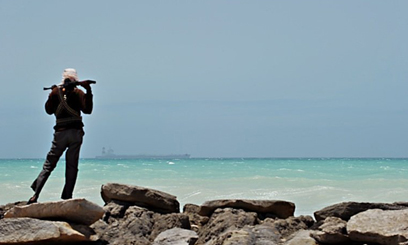The village of mud huts with tin roofs swelters on a turquoise inlet where the Bushbush river meets the Indian Ocean. The Shabaab, commanders say, are on the other side of the creek.
Armoured vehicles move forward to meet the craft. An attack helicopter fires on a Shabaab position with a “whoosh” followed by a dull thud.
“They are engaging” the enemy, explained Seif Rashid, the Kenyan officer in charge of the region.
Since the Kenyans took control of the Burgabo side of the creek, “Al Shabaab has attempted to cross over and cause insecurity … but we have kept them in check and we have been able to repel any activity.”
There have been “a couple of Al Shabaab activities” Rashid explained. “The most recent was last week and we were able to handle it. We have weaponry that can get them over the creek.”
The Kenyan army took the village, without much of a fight, on October 26, days after sending troops into southern Somalia to fight the Al Qaeda-inspired Shabaab, whom it accuses of kidnappings on Kenyan soil.
Kenya’s allies, the troops of Somalia’s transitional federal government (TFG), talk more about the need to send in food aid.
“We are begging Kenya and the rest of the world to assist these people with food and medicine,” the TFG zone commander Mohammed Farah Ali told journalists.
Kenyan soldiers distributed rice to villages, who said it was the first they had received since the troops arrived.
“The problem here is food for my seven children,” said Fatuma Yusuf, who said she was 27 but who looked a lot older as she hurried off with a bag of rice in each hand.
The food aid has become necessary because fishermen can no longer get their catch to market and boats can no longer dock to load sacks of charcoal.
There are goats and a handful of donkeys in evidence but no sign of anyone growing or selling food.
“When the Kenyan forces and the TFG came here Al Shabaab stopped everything,” village elder Omar Bulgas said, speaking through a military translator.
It is also likely the Kenyan army is against having boats dock here for fear of an attack by the enemy.
The ban on boats has also affected the charcoal trade. In the port tens of thousands of sacks of charcoal destined for Dubai are stacked six metres high lining both sides of the road.
A truck unloads another 200 sacks and men tie the tops with raffia.
The Kenyan soldiers are unanimous in saying they work together well with their TFG counterparts, but whilst the Kenyans are in uniform from head to toe and have an impressive array of armoured vehicles, not to mention planes, the men of the TFG are a raggle-taggle bunch.
Some are decked out in black and white scarves, their teeth stained brown from chewing khat leaves, others have ammunition draped across their chests, militia-style, for the cameras.
Both parties say they will be moving forward. Kenyan officers say they can only advance from Burgabo when troops in the other two sectors – central and north – also move.
The reason cited for the delay is the rainy season, which ended only recently.
There is still evidence of recent rain – the thorn bushes are at their brightest and the odd puddle still fills the white sand track that snakes northwards parallel to the coast. But the sun now is blinding even through dark glasses and the ground is drying fast.
“The next objective,” Rashid explained, is “the capture of Kismayu.”










































